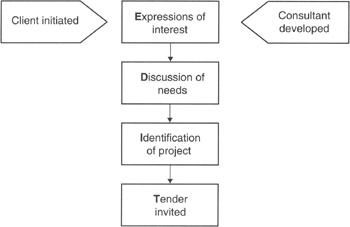PROSPECTION

Figure 4.4: Prospection— The EDIT process
The easiest form of selling is where a client contacts you with a consultancy opportunity and asks for help. Clients will initiate contact only if they have some idea of the services and capabilities you have on offer, so raising and maintaining prospective clients' awareness of them is important. This is the task of promotional marketing, which is dealt with in Chapter 3.
The other (and more usual) method of prospection shown in Figure 4.4 is for the consultancy to be proactive by taking the initiative to develop sales. Strictly speaking, it should not be an option - a consultancy should be proactive anyhow. An opportunity can be developed by the consultancy when:
-
there is an event of some significance for the client (for example, an announcement of business expansion, the loss of a key customer);
-
there is a major change in the client's market sector - for example, new regulatory or environmental restrictions;
-
you have a new service that could be of interest to the client;
-
there is significant development among the client's competitors, which could result in a loss of competitive position;
-
you have a strong view about an operational or strategic aspect of the client's business, and want to draw the client's attention to this.
On this last point it is worth emphasizing that I do believe that consultants can be advocates. It is in our interests to have successful clients - a consultancy firm will not flourish if its clients go out of business. If, therefore, as a consultant you can see an opportunity for a client to develop its business performance, then you should make representations to it about it. Indeed, the account management process in some practices has been formalized with respect to creating opportunities, rather than leaving it to happenstance. Someone in the consultancy account team will have the responsibility for looking ahead at the future needs of the client and making plans for how these are to be met, where appropriate, by providing consultancy support. (This activity is explained in more detail in Chapter 9.)
The 'EDIT' process illustrated in Figure 4.4 shows the progress towards an invitation to tender (ITT) or request for proposal (RFP). The four stages can be thought of as a funnel, as each does not automatically lead to the next. For example:
-
Although the prospect may be interested, there is no immediate need for any activity in this area.
-
Discussion of needs shows that no external support is required.
-
The identification of the project shows that it lies outside the capabilities of your practice.
Only once these hurdles have been surmounted will you receive an invitation to tender.
EAN: 2147483647
Pages: 89